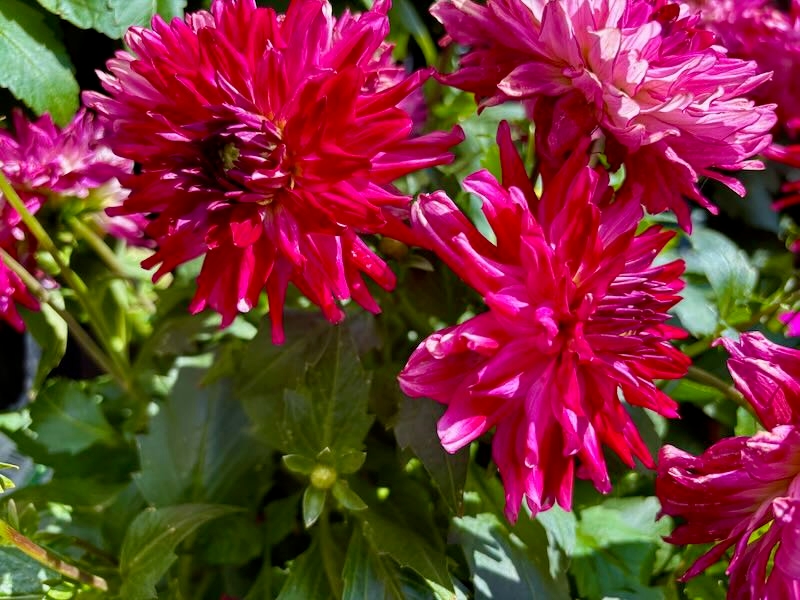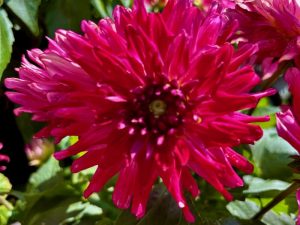Bold Color in a Compact Package: Growing Dahlia ‘Megaboom Raspberry Ice’
Dahlia ‘Megaboom Raspberry Ice’ delivers big drama in a small footprint. This compact yet vigorous cultivar enchants with massive raspberry-red, double blooms touched with white at the center. Its dazzling flowers are balanced on short stems, creating a dense dome of color perfect for garden borders, patio planters, and mixed containers.
Belonging to the family Asteraceae—the same botanical group as Sunflowers, Daisies, and Zinnias—Dahlia is a genus native to the mountainous regions of Mexico and Central America. These tuberous perennials are prized for their breathtaking diversity of flower forms and vivid colors. ‘Megaboom Raspberry Ice’, part of a dwarf series bred by Dümmen, combines all-season performance with a well-contained habit ideal for modern garden spaces.
Eye-Catching Blooms of Dahlia ‘Megaboom Raspberry Ice’
The floral appeal of this cultivar lies in its full, double blooms—large raspberry-red petals swirling around a soft white center. The flowers measure up to 10 cm (4 inches) across, and they bloom steadily from mid-spring until the first autumn frost. The petals have a slight twist that gives them a semi-cactus appearance, adding texture and depth to each flowerhead.
Held just above rich, dark green foliage, these blooms rise on sturdy stems that resist flopping, even in rain or wind. The upright and bushy habit of the plant makes it an ideal candidate for edging borders or anchoring patio containers. It reaches a mature height and spread of 25 to 30 cm (10 to 12 inches), forming a rounded, balanced clump.
Long Season of Color
This variety flowers continuously from late spring until frost. Deadheading—removing spent blooms—encourages even more prolific blooming, keeping the plant looking fresh and full throughout the growing season. The generous flowering habit also makes it a top choice for cut flower arrangements. Its sturdy stems and vibrant colors hold up well in vases.
Asteraceae Family Roots
As a member of the Asteraceae family, ‘Megaboom Raspberry Ice’ shares botanical characteristics with other daisy-like flowers. The inflorescence of a dahlia is technically a compound flower, made up of multiple florets that create a single head, increasing its visual impact and appeal to pollinators.
How to Grow Dahlia ‘Megaboom Raspberry Ice’
Light
Dahlias thrive in full sun, and ‘Megaboom Raspberry Ice’ is no exception. For best blooming, provide at least 6 hours of direct sunlight daily. In hotter climates, some afternoon shade can prevent leaf scorch and prolong flower freshness.
Soil
Rich, well-draining soil is essential. Amend the planting area with compost or well-rotted manure to improve texture and fertility. A slightly acidic to neutral pH (6.5 to 7.0) supports healthy growth and tuber development.
Watering
This cultivar enjoys evenly moist soil but is susceptible to rot if waterlogged. Water deeply once or twice weekly, allowing the top 7–8 cm (3 inches) of soil to dry out between waterings. Container plants may require more frequent watering, especially in summer.
Fertilizing
Dahlia ‘Megaboom Raspberry Ice’ is a heavy feeder. Start fertilizing about a month after planting. Use a balanced, low-nitrogen fertilizer (e.g., 5-10-10) monthly or every two weeks during peak summer growth. Too much nitrogen can produce lush foliage with fewer blooms.
Container Growing
Thanks to its dwarf size and self-supporting stems, this variety is particularly well-suited to containers. Use a 30–40 cm (12–16 inch) wide pot with excellent drainage. Combine with trailing plants or upright accents for a layered container display. ‘Megaboom Raspberry Ice’ can act as a filler or even a thriller, depending on the design.
Pest and Disease Considerations
Common pests include aphids, spider mites, thrips, and slugs. Aphids can be washed off or controlled with insecticidal soap. Slugs and earwigs may be deterred using barriers or baits like iron phosphate-based Sluggo® Plus.
Fungal issues like powdery mildew can develop in humid or overcrowded conditions. Improve air circulation by spacing plants properly and watering at the soil level. Overwatering or poor drainage can lead to tuber rot, especially in containers.
Deer and Rabbit Resistance
Dahlia ‘Megaboom Raspberry Ice’ is not typically a favorite of deer or rabbits, making it a good candidate for areas where browsing is a concern. However, young shoots may still be vulnerable and can be protected with a physical barrier if needed.
Environmental Tolerances
This Dahlia handles urban conditions well, tolerating pollution and compact spaces. However, it is sensitive to frost. In USDA zones 8–11, tubers may overwinter in the ground with mulch protection. In cooler regions (Zones 3–7), treat it as an annual or lift tubers after the first frost.
Winter Care and Tuber Storage
In frost-prone regions, dig up the tubers in late autumn. Let them air dry for a few hours, then store them in peat moss or vermiculite in a cool, dry location (4–10°C / 40–50°F). Check occasionally for signs of rot or dehydration.
Propagation of Dahlia ‘Megaboom Raspberry Ice’
Propagation is usually done via division. In spring, before planting, divide the overwintered tubers ensuring each section has at least one viable eye. You may also propagate via cuttings taken from young shoots in early spring.
Garden and Design Uses
Dahlia ‘Megaboom Raspberry Ice’ offers maximum visual reward with minimum space requirements. Its compact form and show-stopping blooms make it ideal for:
- Small-space gardens
- Fronts of borders
- Patio pots and balcony containers
- Mixed flower beds
- Seasonal displays
It also excels as a cut flower, holding well in arrangements and attracting butterflies, bees, and hummingbirds in the garden.
Conclusion
Compact in stature but bold in bloom, Dahlia ‘Megaboom Raspberry Ice’ brings nonstop color and classic charm to any garden. Its ease of care, strong stems, and floral drama make it a standout among container plants and border selections. With just a bit of sunlight, rich soil, and seasonal upkeep, this dahlia can brighten even the smallest garden spaces from spring through fall.



